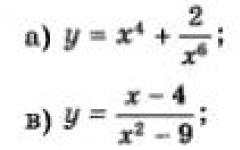Text 1
Law and law
[There is the following understanding of the essence of law]: law is not laws adopted by democratically elected institutions and expressing the sovereign will of the people, but general (abstract) principles of humanism, morality, justice. But such fuzzy, amorphous ideas about law alienate us from the desired legal order and the tasks of strengthening it, because the indicated principles and ideas (“unwritten law”), despite their undoubtedly high value, still cannot by themselves, without the necessary formalization , serve as criteria of lawful and illegal, legal and illegal, and therefore, unable to ensure stability and organization in society. Disappears regulatory framework right, its regulatory role is undermined.
In this case, there is scope for ... arbitrariness, since freedom, democracy, morality are understood by various political subjects, including those in power, in different ways ... And why laws (normal, humane, created in compliance with all generally accepted procedures) are not can express the above ideals? There is also a difficult question about who and how should determine - "legal" this or that law or "unlawful"? Where are the criteria? Who are the judges?
Of course, the categories of law and law do not coincide. Law is one of the forms of expression of law ... their identification is inadmissible. But an excessive opposition of these two concepts does not lead to the achievement of positive goals. This gives rise to legal nihilism ...
N.I. Matuzov
C1. Indicate two approaches to understanding the essence of law, described in the text.
C2. Which of these approaches, from the point of view of the author, is the correct one? Give any three arguments by which the author shows the failure of another approach.
SZ. What term, equivalent to the term "source of law", is used in the text? Does the author believe that laws are the only source of law? Based on your knowledge of the social studies course, indicate three other sources of law.
Text 2
“Society cannot do without social regulation, in the system of which law has a leading role. Law is part of social control, it expresses the basic postulates of a given society, based on government support... Law as a social institution is a way of regulating people's behavior, a measure of their freedom, which finds its expression in the system of generally binding social norms established or sanctioned by the state, regulating the actions, behavior and relations of people (their groups, state and public bodies, organizations and institutions) and secured by state coercion or its threat.<...>
The generally binding systemic and normative nature and essence of law predetermine its primary role in social management social life, where the objects and at the same time the subjects of such management are both individuals and their groups, and social institutions and organizations. Since the emergence of the political organization of society, it is the law that has played the most important role in keeping people from antisocial behavior and ensuring the fulfillment of their duties for the benefit of a civilized society. This provision objectively reflects the place and role of law in historical development humanity and, of course, is not aimed either at artificially diminishing the importance of morality and religion, customs and traditions in social control, or at recognizing any right always and under all conditions as the embodiment of humanism and civilization.<...>
There is no dispute between "law" and "right" - closely interrelated and interpenetrating concepts that are wrong to break, and even more so to oppose. But they cannot be identified either "
Tadevosyan E.V. Sociology of law as a specific branch of sociology
// Social and humanitarian knowledge. 2000. No. 2. S. 102-104.
C1. Relying on the text, reveal the essence of law. What are the characteristics that distinguish it from other social institutions?
C2. What is the role of law, according to the author, in the historical development of mankind? Explain why this role is due.
SZ. The author argues that not every right and not under all conditions is the embodiment of humanism and civilization. Provide examples of states with such legal systems, based on knowledge of the social science course.
C4. Explain how the concepts of "law" and "law" relate to each other. Which one is broader in content? Provide three relevant justifications.
Text 3
The main place among the public relations, regulated by civil law, is occupied by property relations in the form of goods and money, associated with the possession and disposal of property. In civil law, property is understood not only things, money, securities, but also property rights (for example, a deposit in a bank is nothing more than a right of claim). Property relations always arise and exist either in connection with the finding of property with a certain person (property relations), or in connection with the transfer of property from one person to another (obligations). Material relations mediate the right to a thing in statics, i.e. associated with belonging, possession of this or that property, about which an agreement has not been concluded. The owner of a thing treats it as his own, i.e. owns, uses, disposes, and also bears the burden of care and maintenance of property. On the other hand, the owner of the thing has the right to eliminate the interference of other persons in his property activities, i.e. has absolute protection, defending its real right against everyone and everyone, including against the state. /… /
Obligatory relations mediate only the right to a thing in dynamics, i.e. associated with the transfer of property benefits from one person to another, they implement the process of exchange of objects of civil rights. Obligations can arise from different reasons, the most important of which is a contract, as well as a unilateral transaction. Liabilities can also arise from harm by one person to another, from unjust enrichment. Personal non-property relations are those relations, the subject of which is non-material goods, / ... / inseparable from the personality. Personal non-property relations can be subdivided into: directly related to property, i.e. such relations, entering into which may entail property consequences for the subject of these relations / ... /; non-property relationships also include purely personal relationships.
(T.V. Kashanina, A.V. Kashanin)
C1 What is property in civil law? In what form does property relations exist?
C2 Based on the text, indicate what is the similarity and what is the difference between the concepts of “material relations” and “obligation relations”.
C3 Indicate any three reasons for the obligation as highlighted in the text. Describe as an example any situation where any of the obligations you specify arise.
C4 The text speaks of two types of non-property relations. Give one example of each. Using one example, explain how non-property relations can be related to property.
Text 4
Citizenship in Ancient Athens
The entire set of rights and privileges was enjoyed (according to the law of Pericles) only by those persons (males) whose father and mother were natural and full-fledged citizens of Athens.
Citizenship was acquired from the age of 18. Then, for two years, the young man passed military service... From the age of 20 he was allowed to participate in the national assembly. The formal equality of full citizens did not exclude their actual inequality, determined by the inequality of property. The situation of the freed slaves was close to that of foreigners. Human dignity was recognized for them. It's a different matter, slave. The slave was only a thing, its living likeness. It could be sold and bought or leased. He couldn't have a family. The children that he had taken root from the relationship with the slave were the property of the owner.
The only thing that the law forbade the master was the killing of a slave.
The position of women in Athens deserves special mention. She had neither political nor civil rights.
Citizenship in Ancient rome
Roman citizenship was acquired by birth from a full-fledged father and mother. Upon reaching adulthood, the Roman youth became politically equal.
Roman citizenship was lost through the sale into slavery for debts or crimes, as well as through exile or exile.
Political full rights did not yet mean “civil” full rights, that is, the right to dispose of property. While the father was alive - and the son, by tradition, was under his authority (that is, as part of the father's family), he could not make any transactions with things and money, if there was no direct authorization from the father. Both political and civil rights were the property of men. This, of course, does not mean a complete exclusion of women from participation in family and community affairs. The woman's influence was indirect, but quite significant. With the upbringing of children, the position of the mistress of the house, family ties, her intelligence, charm, and finally, her heroism, the Roman woman more than once exerted a decisive influence on the fate of her native city.
C1. What did citizenship in Ancient Athens and Ancient Rome have in common?
C2. What was the expression of the full rights of a citizen in these states?
C3. Prove that the title of citizen was honorary both in Ancient Athens and in Ancient Rome.
C4. Give an assessment of the legal status of women in Ancient Athens and Ancient Rome. Express your attitude towards him.
Read the text and complete assignments 21-24.
Society cannot do without social and then political institutions - stable social or political institutions, institutions, associations and communities that perform social or political functions necessary for society.
Together with human society, social power arises as its integral and necessary element. It gives integrity to society, serves as the most important factor in organization and order. Under the influence of power, social relations acquire the character of controlled and controlled ties, and the joint life of people becomes organized. Thus, social power is an organized force that ensures the ability of a particular social community (ruling subject) to subordinate people (subjects) to its will, using various methods, including the method of coercion. It is of two types: non-political and political.
Power cannot function apart from the will and consciousness of people. The will is essential element any social power, without taking into account which it is impossible to understand its nature and the essence of relations of power. This is due to the fact that power means, on the one hand, the transfer (imposition) of those who are in power to those who are in power, and on the other hand, the subordination of those who are subordinate to this will. Will firmly connects power with its subject: power belongs to that social community, the will of which is embodied in it. Subjectless, that is, not belonging to anyone, there is no power and cannot be. That is why in the doctrine of power an important place is occupied by the concept of "ruling subject" - the primary source, the primary carrier of power.
Power is impossible without the objects of its influence - individuals, social groups, society as a whole. Sometimes the subject and the object of power coincide, but more often the ruling and subordinate are distinctly different and occupy different positions in society.
Emphasizing the importance of will as one of the defining elements of power, one should not diminish its other structural elements, in particular, such as strength. Power can be weak, but devoid of strength, it ceases to be real power, since it is not able to translate the will of power into reality. Power is stable due to the support of the masses, that is, it is based on the power of authority. To impose his will on his subjects, the ruling subject often relies on ideological influence, including deception and populist promises. But power, especially state power, has substantive and material supports - coercive organs, armed organizations of people.
The defining feature of power is the ability of those in power to impose their will on those around them, to dominate those who are under their control. Hence the negative side of power, expressed in the possibility of its abuse and its arbitrary use. She often becomes the subject of acute struggle and clashes of people, political parties, layers and groups.
Explanation.
A correct answer must contain the following elements:
1) two main elements that form the system of social power:
Will and strength;
No society can do without social regulators, with the help of which the behavior of people is ordered. Where there is a society, there must be rules of community, or social norms. Social norms determine a person's behavior in society, and, consequently, a person's attitude towards other people.
Any rules or requirements established by a person in relation to himself cannot be regarded as social, since the latter necessarily imply a person's appeal to another person.
Social norms are not applicable in the field of regulation of human relations with the animal world, since for the process of the emergence and existence of social norms and relations, their awareness and understanding is necessary first of all.
The object of regulation of social norms is the behavior of those subjects to whom they are addressed, that is, social relations.
Social norms are the rules that govern the behavior of people and the activities of organizations in relations with each other.
Social norms are diverse, but a number of common features, one way or another characteristic of all these norms. Social norms have the following characteristics:
These are the rules of human behavior, i.e. patterns of behavior, measures of proper and possible behavior of subjects;
They are general in nature (their requirements do not apply to a specific person, but to many individuals);
These are compulsory rules of behavior (however, compulsion manifests itself in different ways; compulsory and compulsory should not be confused - not all rules are compulsory).
To the system of social norms modern society include law, morality, customs, religious norms, etc. The differences between them
are carried out according to the methods of establishing and forms of expression, according to the content and methods of influencing the behavior of people and social relations, according to the means of protecting these norms from violations. The diversity of opinions on a clear definition of the list of social norms can to a certain extent be explained by the fact that the process of differentiation of social norms has not yet been completed (most of all, law has become isolated, less morality).
The norms of morality (morality) are the rules of behavior that are established in society in accordance with people's ideas about good and evil, justice and injustice, duty, honor, dignity and are protected by force public opinion or inner conviction.
Political norms are the rules of conduct that have developed in political system society, apply to a variety of subjects of political relations and regulate relations regarding the implementation, functioning of state power in a given society.
Corporate norms - rules of conduct that are set by ourselves public organizations and are protected by measures of public influence provided for by the statutes of these organizations.
The norms of customs are the rules of behavior that have developed in a certain social environment and have become a habit of people (performed by force of habit) as a result of repeated repetition.
Traditions are orders and rules of conduct passed down from generation to generation.
Today, traditions also mean the rules for holding any celebrations that are significant for a person or group of people (wedding, birthday, etc.). Traditions in property relations are called business customs or business customs. So, in Art. 5 of the Civil Code of the Russian Federation provides for the possibility of applying stable rules that do not contradict the law in entrepreneurial activity. Article 13 of the Arbitration Procedure Code of the Russian Federation establishes that “the arbitration courts
9.2. The ratio of law and morality
in cases stipulated federal law, apply the customs of business turnover. "
It is necessary to distinguish customs from rituals and ceremonies. A custom establishes a framework for the expediency of an act, and a ritual is a specific design of established social relations (rituals can be marriage, military, etc.).
Customs should not be confused with customary law. Customary law - the norms of primitive customs sanctioned by the state, reflecting the interests of the community and protected by the force of state coercion. Today, customary law exists in some countries in South America, Southeast Asia and Africa. But even in developed countries, the norms governing marriage and family relations, inheritance, there are customs legalized by the state.
In addition, there are other social norms: religious, family, norms of etiquette, rituals, ethics, etc.
Among social norms are the norms of law.
Legal norms are generally binding, formally defined rules of conduct established or sanctioned by the state, acting as a regulator of social relations and secured by state coercion.
Legal norms occupy a special place among social norms, since they have a number of specific features. In particular, only legal norms have formal certainty (the presence of stable sources, a clear indication of the circumstances entailing the occurrence of offenses, the very rules of behavior, the consequences of their non-observance); state security (if the requirements of legal norms are violated, coercive measures may be applied); close relationship with the state (legal norms come from competent government agencies or authorized by them); representative-binding character (in the legal norm, the subjective right of one subject is opposed by the legal obligation of another subject).
You can also find information of interest in the scientific search engine Otvety.Online. Use the search form:
More on the topic Social norms: concept and types:
- 36. The concept of the rule of law. Difference between legal and social norms
- Section III CURRENT CONCEPT OF LAW. MORAL-ADEQUATE LAW AS A SYNTHESIS OF POSITIVE PROPERTIES OF VARIOUS SCHOOLS OF LAW Topic 13 CONCEPT OF SOCIAL REGULATION. SOCIAL NORMS







